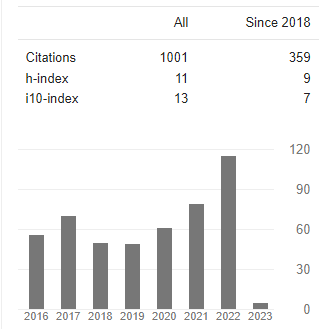CONTINUOUS PROFESSIONAL DEVELOPMENT: A PANACEA FOR TEACHERS
Abstract
An important strategy to guide the country towards becoming a fully developed economy is the development of its human resource. Universal access to quality education is a stepping stone towards human resource development. To realising this goal, the Indian government has been spending billion of rupees on education. The role of teachers in this context can not be overlooked. As schools continue to change and educational reforms continue to dominate the education scene, teachers are expected to develop themselves, update their knowledge and skills, and remain current. Continuous Professional Development (CPD) helps to facilitate learning and development among educators, specifically to learn to cope with new and changing roles and new approaches to teaching. It enhances teachers’ capabilities and competencies and enables them to keep abreast of current issues, and helps them implement innovations and refine practices. This paper traces the meaning, principles and importance of Continuous Professional Development in harnessing skills and broadening the knowledge of teachers.
Downloads
References
Barber, M. & Mourshed, M. (2007). How the world’s best performing school systems come out on top?
Barber, M. & Mourshed, M. (2009). Shaping the future: How good education systems can become great in decade ahead. Report on the International Education roundtables, Singapore.
Boyle, B., While, D., & Boyle, T. (2004). A longitudinal study of teacher change: What makes professional development effective? The curriculum Journal, 15, 1, 45-68.
Bredeson, P. (2000). Teacher learning as work and at work: Exploring the content and contexts of teacher professional development. Journal of In-service Education, 26, 63-72
British Psychological Society (2006). Retrieved 25 October, 2006 from web site:http://www.bps.org.uk/
Bubb, S. (2004). The insider’s guide to early professional development: Succeed in your first five years as a teacher. London and New York: Routledge Falmer
Bureau of International Cooperation (2005). Supporting professional development. Bangkok: The Office of the Permanent Secretary for Education.
Carey, K. (2004). The real value of teachers: Using new information about teacher effectiveness to close the achievement gap. Thinking K–16, 8(1), 3–42.
Chartered Institute of Personnel and Development (2008). Retrieved 12 April, 2008 from web site:http://www.cipd.co.uk/default.cipd
Clarke, D, & Hollingsworth, H. (2002). Elaborating a model of teacher professional growth. Teaching and Teacher Education,18, 947–967.
Craft, A. (1996). Principles of professional and institutional development. In Continuing Professional Development: A practical guide for teachers and schools (pp. 36-50). The
Open University: London.
Davies, J.L. (1995). The training of academic heads of department. In Brew, A. Directions in staff development. (1st ed.) London, UK; The Society for Research into Higher Education & Open University Press.
Day, C., & Sachs, J. (2004). Professionalism, performativity and empowerment: Discourses in the politics, policies and purposes of Continuing Professional Development. In C. Day & J. Sachs (eds.), International Handbook on the Continuing Professional Development of Teachers. (pp.3-32). Berkshire: Open University Press.
Dussault, M. & Barnett, B. G. (1996). Peer-assisted leadership: Reducing educational managers’ professional isolation. Journal of Educational Administration, 34(3), 5-14.
Ferguson, L. D. (2006). Re-conceptualizing Continuing Professional Development: A Framework for Planning
Fraser, C. (2005). Towards a unified model of professional development? School of Education: University of Aberdeen.
Friedman, A., & Phillips, M. (2004) Continuing Professional Development: Developing a vision. Journal of Education and Work, 17, 361-376.
Goodal, J., Day, C., Lindsay, G., Muijs, D., & Harris, A. (2005). Evaluating the Impact of Continuing Professional Development (CPD). Retrieved 7 December, 2005 from web site: http://www.dfes.gov.uk
Gray, L. S. (2005). An Enquiry into Continuing Professional Development for Teachers
Gusky, T. R. (1999). Evaluating professional development, USA: Crowin Press.
Imants, J.G.M., Van-Putten, G. M. & Leijh, G. (1994). School management training. International Journal of Educational Management, 8(3), 7-14.
Sydow, D. (2000). Long-term investment in professional development: real dividends in teaching and learning. Community College Journal of Research and Practice, 24, 383- 395.
Terrell, I., Powell, E., Furey, S. & Scott-Evans, A. (2003). Teacher's Perceptions of the Impact of CPD: an institutional case study. Journal of In-service Education, 29, 3, pp. 389-404.
Training and Development Agency for Schools (2005). Retrieved 7 December, 2005 from web site:http://www.tda.gov.uk/















